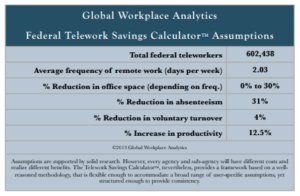In 2010, Congress passed the Telework Enhancement Act (“the Act”), which required federal agencies to put official telework policies in place. The history and statutory framework for telework grew out of a need to tackle transportation issues and served as a powerful recruitment and retention tool for the Federal Government. Telework has the potential to improve employee morale, enhance work-life balance, improve the capacity to achieve mission and operational goals, and increase productivity. With the advent of the Telework Act, telework is now also a method for managing disruptions to the workplace during times of severe weather or other emergencies, as well as a way to reduce the overhead costs and real estate footprint of the Federal Government.1 Over one million federal employees (about 45 percent of federal employees) were eligible to telework in 2013, and one quarter of that number participate in telework full-time or a few days a week. As such, agencies are now integrating telework as a customary human capital practice for their workforces. To measure agency progress in achieving established telework outcome goals, the Act requires an assessment of the underlying value of telework programs.
The problem now, the Government Accountability Office (GAO) says in a new report, is that federal agencies are having a difficult time supporting assertions that telework is beneficial to agencies. GAO studied telework policies at six agencies of various sizes: the Agriculture Department, Department of Transportation, Environmental Protection Agency, Federal Deposit Insurance Corp., General Services Administration and the Merit Systems Protection Board.
All of the agencies cited positive effects of letting some of their employees work from home. But, auditors found that the programs “had little data to support the benefits or costs associated with their telework programs.” The report goes on to state, “agencies continue to face challenges in quantifying the impact of telework, identifying costs incurred, and translating benefits into quantifiable cost savings. Without data on net benefits, including cost savings associated with telework, agencies have incomplete information to determine the value of telework through assessing whether the benefits being achieved outweigh the costs incurred.” 2
It is possible to measure the benefits of telework policies, and The Clearing has successfully quantified government agency telework policies. Through our decades of experience working with federal agencies, we have found agencies often lack sufficient data sets or have too much data. The former leads agencies to believe that they cannot derive accurate analysis, and the latter often makes it too difficult to know where to begin. Both of these scenarios often lead to “analysis paralysis” and the conclusion that quantitative analysis is simply not possible.
We posit that the law of large numbers allows for an accurate analysis of teleworking when there is not much data or when there is too much data. In probability and statistics, the law of large numbers states that as a sample size grows, its mean gets closer to the average of the whole population. In layman’s terms, when analyzing telework policies, this means that the use of “averages” is an accurate methodology to determine the value of telework benefits. Large data sets would revert to the mean, and if there are no data sets to be had, reverting to the mean is appropriate.
At The Clearing, we help federal clients quantify the various methodologies for determining telework cost/benefits when there is little to no data or when there is too much data to be useful. Let’s review a few examples:
CONTINUITY OF OPERATIONS (COOP) EVENTS
Let’s say a major snowstorm shuts down the D.C. area for one day. Because a portion of your staff is set up for telework, they can continue to productively work from home. How would you calculate this benefit? We calculated this very scenario for a federal agency in the D.C. area. Through research, we discovered the following:
- Federal estimates of productivity per day for the DC Federal workforce = $100 million3
- Total number of DC Federal Workforce = 270,000
With this data, we were able to determine that the average productivity per day of a D.C. Federal employee equates to $370 ($100 million/270,000). If 1,000 of your employees were set up to telework, this would equate to over $370,000 in productivity saved per day during a COOP event. What’s important to note is that very little data was required from the Federal Agency – just the number of employees that could telework.
TRANSIT SUBSIDY
Agencies save money when they no longer need to pay all or part of an employee’s transit subsidy.
Suppose an agency has 200 teleworkers working three days a week from home–100 teleworkers working five days a week from home and 50 teleworkers working one day a week from home. If transit subsidies run $1,500 per year/ per employee, this agency would save:

INCREASED EMPLOYEE PRODUCTIVITY AND A DECREASE IN EMPLOYEE-RELATED COSTS
Research has shown that the value of gains from mobile working due to increased productivity, as well as reduced turnover, absenteeism, and real estate costs, equates to $10,000 per year based on an employee working 2.5 days from home per week.4 If agencies are not actively quantifying how much more productive their employees are or their reduction in turnover and absenteeism due to telework, the $10,000 average is a very reasonable figure to use.
CARBON EMISSIONS REDUCTION ANALYSIS
One of the interesting benefits of teleworking is the net benefit to society through the reduction of carbon emissions due to the fact that more cars are off the road. Agencies often struggle over this analysis because the calculation to determine the reduction in carbon emissions requires knowing how many miles employees avoid driving when they stop commuting to work.
By grouping payroll zip codes, it does not take long to determine the average mileage for employees:
| Round-trip commuter miles | 46 |
| Number of work days per year | 228 |
| Number of mobile workers | 300 |
| Bureau of Transportation average fuel economy (mpg) | 23.8 |
| Dollar value of a metric ton of carbon (U.S. Government average) | $20 |
These figures, coupled with the average number of days their employees telework per week, produces the carbon emissions reduction analysis.
COSTS ASSOCIATED WITH TELEWORK
Setting up and administering a telework endeavor comes with associated costs. Here again, federal agencies often struggle with quantifying these costs. Our advice is the same. If precise data is unavailable, the cost associated with telework is going to be a portion of an agency’s:
- cloud computing
- IT setup and maintenance
- furniture, fixtures, and equipment (FF&E)
- consultant costs
Agencies should also allocate the amount of staff hours that they associate with the telework project. If all or portions of salaries cannot be directly allocated, then agencies should use the average GS salary of the employees working on the telework endeavor.
SUMMARY
Quantifying accurate teleworking benefits can be accomplished in the absence of large data sets or in spite of voluminous and often confusing data. In accordance with the law of large numbers, reverting to the mean will bring agencies within an acceptable margin of error when calculating teleworking benefits. Agencies can showcase the benefits of telework from a reduced real estate footprint, greater employee productivity, productivity during COOP events, and lower transit subsidies. Given the growth and significance of telework programs, it is important to do so.
1 https://www.telework.gov/guidance-legislation/telework-legislation/background-history/
2 http://www.gao.gov/assets/680/678465.pdf
3 Data from OPM referenced in article from Federal Times, “‘Snowmageddon’ Drives Call for More Telework,” February 21, 2010
4 Workshifting Benefits: The Bottom Line,” Telework Research Network, May 2010






 The Clearing’s Employee Experience
Improvement model, adapted from Itam
& Ghosh, 2020, focuses on three objectives:
The Clearing’s Employee Experience
Improvement model, adapted from Itam
& Ghosh, 2020, focuses on three objectives: 














